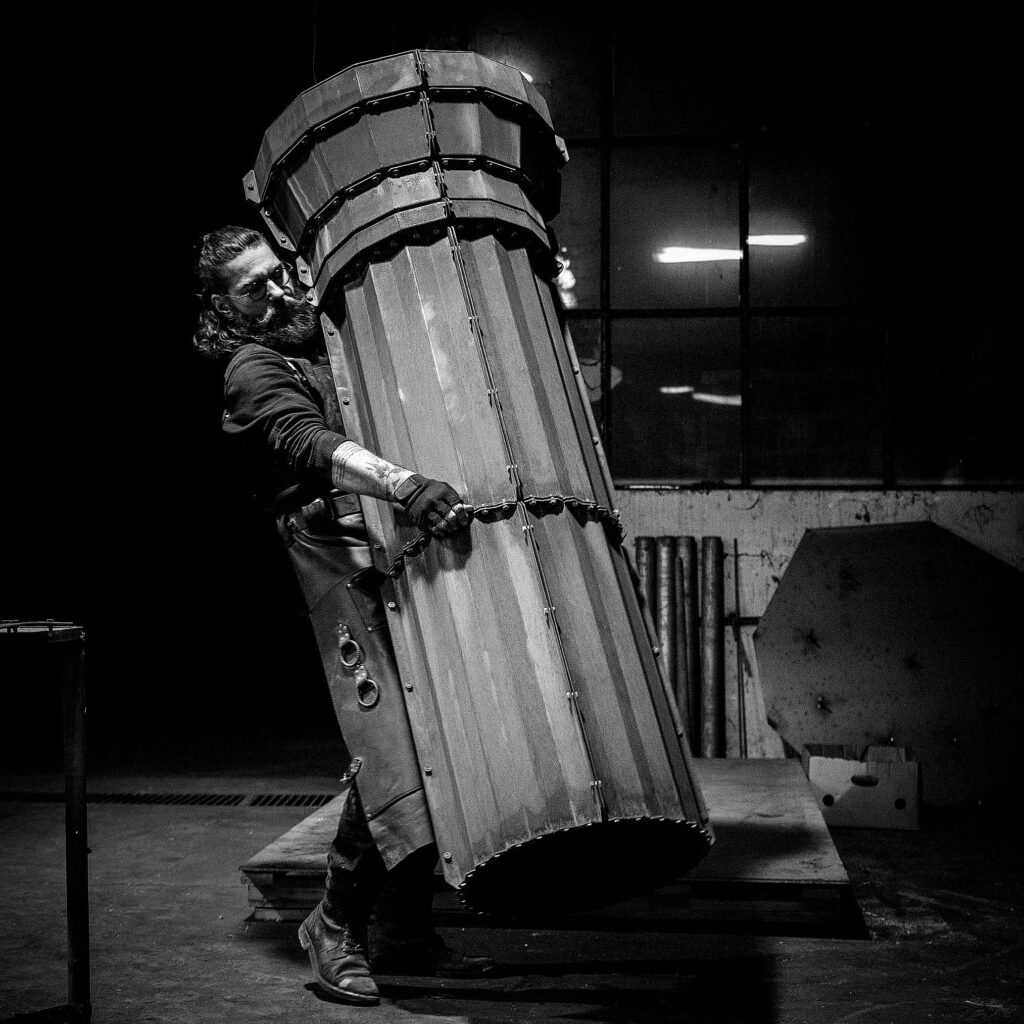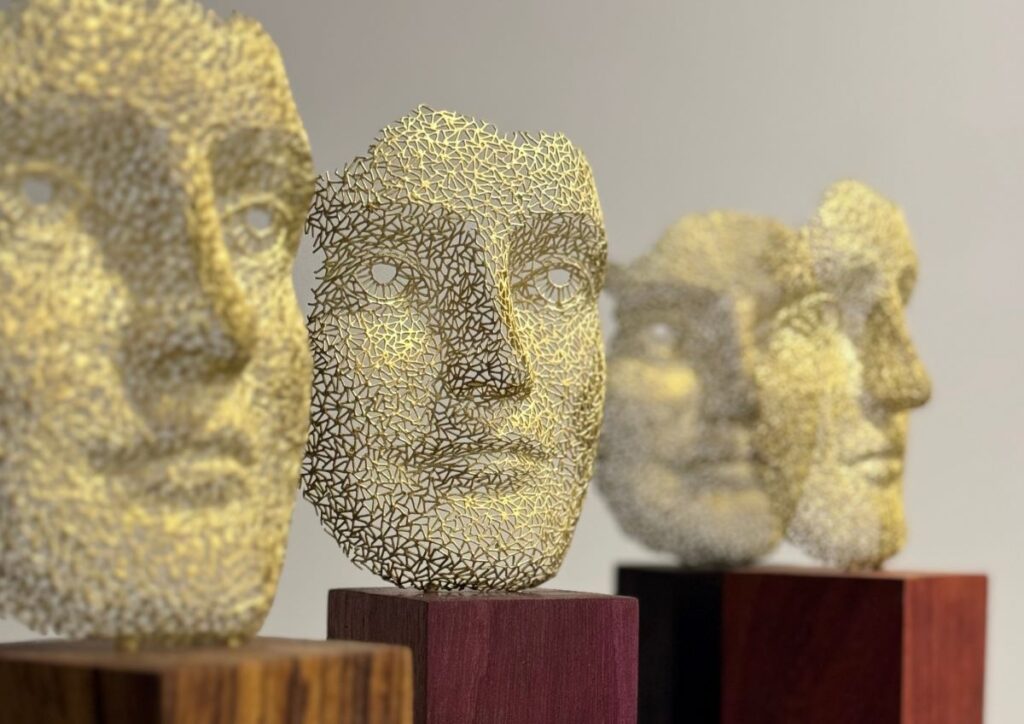
The Artistic and Philanthropic Impact of Nikola Vudrag
Sculpting Myths & Philanthropic Visions
Nikola Vudrag, born in 1989 in Croatia, was introduced to metalworking at an early age by his father and grandfather who were both skilled metalworkers. This early exposure resulted in a deep fascination with the medium, prompting Vudrag to pursue a career as a contemporary sculptor using the generational skills running through his family—as the artist eloquently explained in our recent conversation with the Croatian sculptor. He began his studies at the Academy of Applied Arts in Rijeka before transferring to the Academy of Fine Arts in Zagreb, where he was honored as the best student in 2012. So perhaps it is not a surprise to see Vudrag’s work as public sculptures across Croatia and in significant international exhibitions. But what is the impelling force of all this myth and metal?
Vudrag’s artistic practice is characterized by his ingenious use of metal, particularly CorTen steel, iron, bronze, and aluminum. His works often feature meticulous details and monumental designs, drawing inspiration from nature, science, philosophy, and mythology.
Vudrag’s fascination with mythology is evident in his series of sculptures that reinterpret ancient stories through modern materials. His “Apples of the Hesperides,” exhibited at the Malta Biennale, is inspired by the Greek myth of Heracles. This sculpture represents the selflessness and transformative power of philanthropy, mirroring the mission of the OmenaArt Foundation. Made from CorTen steel, the sculpture features a glowing core, symbolizing the interconnectedness of humanity and the illuminating power of selfless acts.
“Vudrag points out that by choosing this work for the exhibition, the OmenaArt Foundation accepts the spirit of Heracles, devoting itself to helping those in need, without expecting anything in return. Like Heracles, the Foundation prioritizes the well-being and upliftment of others above self-interest, while forging a deep connection between ancient myths, philanthropy, and artistic expression.”1

Similarly, his sculptures of “Atlas” and “Prometheus,” displayed during the Venice Biennale in the exhibition “Personal Structures — Beyond Boundaries,” explore themes of rebellion, resilience, and the human condition. “Atlas” is depicted as a hand gripping a classical pillar, symbolizing the burden and strength required to uphold the world. “Prometheus,” bound by chains, represents defiance and the pursuit of knowledge. These works draw a direct link between ancient myths and contemporary issues, highlighting the timeless relevance of these stories.
“Having a passion for collecting, learning, and reading old books, I noticed the repetition of certain patterns in these stories, which I tried following to the source. I began to realize that if the story has been repeated in various forms for thousands of years, there must be a certain message that needs to be heeded. Ultimately, the ones I deciphered and understood helped me to understand myself and the world around me better. I shaped them into sculptures or symbols that still resonate with the human experience and the times in which we live.”2
It is safe to say Vudrag’s sculptures are imbued with profound symbolism and meaning, often drawing from mythological narratives to address contemporary issues. His work is a testament to the power of ideas to shape our world, challenging viewers to think critically about that very human condition. By merging industrial materials with artistic innovation, Vudrag creates works that are both timeless and deeply relevant to today’s cultural and social landscape.

There is also a natural analogy to be found between his medium and the message, as Nikola Vudrag explained in our interview. A connection between his mythological subjects and the transformative power of sculpture, being able to manipulate a substance into becoming something else, as if a shapeshifter.
“CorTen steel has a special ability to preserve itself with the rust that usually destroys normal metals. I love the irony in the oxidation process of CorTen steel, which, unlike ordinary raw iron, has a mixture of various metals, such as copper and brass, which gives it longevity and a certain warmth. In that sense, CorTen, as a mixture of basic and noble metals for me, is the blood of the earth, something like “Ichor,” an ethereal fluid from Homeric myths also known as the blood of gods and titans.”3

As a result, the matter itself consists of almost mythical properties, acting as the foundation of the power and alchemy of his sculptural practice. The connection between the subject matter and functional matter can be seen as a metaphor for the harmony between thought and deed, the world of ideas and the physical world, the invisible and the visible, the elusive and the tangible.
Vudrag’s practice is incredibly versatile. Think of his Diamond Collection, which features larger-than-life sculptures of diamonds crafted from CorTen steel. These pieces combine the simplicity of design with the luxury associated with diamonds, examining the interplay between collectible objects and art. Think of one of his latest site-specific installations titled “The Seven Realms” of seven black, shiny diamonds, representing the UAE’s differing landscapes, exhibited at Dubai’s Jetex FBO Terminal—the biggest and most luxurious facility in Dubai, which has received numerous nominations and distinctions for its unique design.
His diamonds are also created in the characteristic and weathered patina of steel, adding visual appeal and suggesting stability and endurance. One standout piece in this collection is an illuminated diamond sculpture, symbolizing the transformation of ideas into tangible reality—similar to the use of light in the aforementioned “Apples of the Hesperides,” showing an interplay of recurring motifs and concepts in different parts of the artist’s oeuvre. By doing so, the juxtaposition of raw steel with an illuminated core represents the creative process and the power of ideas to shape the physical world.
Or what about his Net-Work series, which presents human personality through intricately welded CorTen rods? Each piece, comprising thousands of small rods, is chemically rusted and protected with a high gloss varnish. This series explores the concept of persona, with individual capturing the essence of human expression. The background plays a crucial role in these sculptures, enhancing their visual impact and emotional resonance. Yet, recently, an even more versatile function was found with this trademark sculptural oeuvre; awards.

He was entrusted with creating the prestigious “TOP CHARITY” awards for the Grand Charity Auction in Warsaw, which recognized individuals dedicated to humanitarian efforts. These awards, designed as masks and mounted on exotic wood stands, celebrated self-expression and the complexity of human nature from a philanthropic perspective—once more embodied by Vudrag’s sculptural practice, using his sculptures to inspire while making a meaningful difference in society.
Vudrag’s work can be compared to that of other renowned contemporary artists and sculptors. His use of mathematics to defy physics and create large-scale public installations is reminiscent of Anish Kapoor, known for his monumental and reflective sculptures. For instance, in his “Deus ex Machina” series, Vudrag defies gravity and physics, drawing inspiration from Greek mathematicians and philosophers.
These sculptures feature complex interlocking shapes and patterns, appearing to float in mid-air through the use of counterweights and balanced structures. This series is both visually stunning and intellectually stimulating, inviting viewers to contemplate the relationship between art, science, and nature. There are also material and visual connections, such as the use of industrial materials in the tradition of Minimal Art, exemplified by the patina of the Corton steel, which engages in an art historical dialogue with none other than Richard Serra.

For instance, in Vudrag’s animal sculptures, such as the “Musk Ox” and the tribute to Sudan, the last white rhino, he showcases his ability to capture the essence of his subjects through minimalistic design—yet remaining in the realms of representational art. Made from metal polygons and CorTen steel, these works highlight the beauty and strength of the animals while emphasizing the importance of conservation. Or how the minimal use of industrial materials can alchemically transform in something enlightened, sublime, and inspiring.
To conclude, Nikola Vudrag is a significant figure in contemporary art, distinguished by his technical mastery, thematic depth, and commitment to philanthropy. His sculptures, rich in symbolism and meaning, challenge viewers to think critically about the world around them. Through his innovative use of metal and his engagement with mythological narratives, Vudrag creates works that are both timeless and profoundly relevant to today’s cultural and social landscape. His participation in major international exhibitions and philanthropic initiatives further cements his status in the art world. To be continued.
Notes:
Last Updated on June 20, 2024

Sculpting Myths & Philanthropic Visions

A Digital Playground

Barbé Gallery, Ghent, BE

A Complete Guide